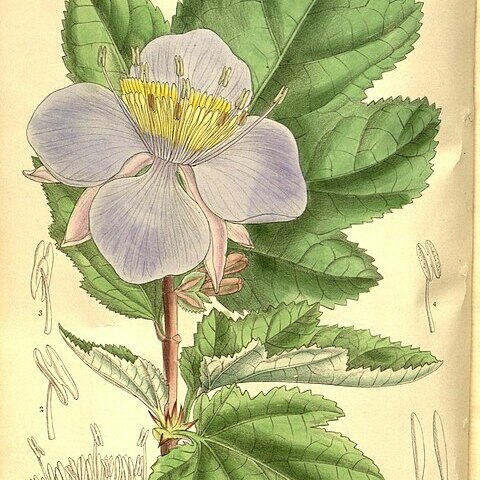Leaf-lamina up to 13 × 7 cm., broadly ovate to oblong, usually rather deeply 3–7-lobed, with the lobes rounded or blunt at their apices and with the apical one broader and larger than the remainder, margins coarsely serrate, base 5–9-nerved, cordate, truncate or broadly cuneate, stellately pilose above, tomentose beneath; petiole up to 4 cm. long but often less; stipules up to 1·2 cm. long, rather leafy, lanceolate-acuminate.
Inflorescences of terminal racemose cymes, the floral leaves much reduced; peduncles up to 2·5 cm., lengthening in fruit, stellate-tomentose; pedicels usually single or in pairs, up to 10 mm. long, rufous-tomentose, articulated about half-way; bracts up to 13 × 7 mm., oblong-lanceolate, stellate-tomentellous outside, strigose-pubescent within.
Stamens very numerous, slightly connate at the base, c. 12 slightly longer than the rest with narrow elongated anther-thecae 3–4 mm. long united by a connective c. 1 mm. long across their middle; staminodes filiform or lanceolate-linear and sterile, c. 2 cm. long.
A woody herb or small shrub that grows in water. It grows about 2 m high. The leaves and stems have a grey coating. The leaves can be simple or have 3-5 lobes. They can be heart shaped. The leaves are 13 cm long by 7 cm wide.
Capsule c. 5 × 2·5 cm. including the bristles, oblong-ovoid, obtuse at both ends, pubescent, covered outside with numerous stiff ciliate bristles, each terminated by a deciduous hyaline straight or bent seta.
Ovary an elongate cone densely covered with hyaline setulae; style 2–4 cm. long, setulose-pubescent at the base; stigmas 4–8, spreading or recurved, linear, purplish.
Sepals 3–4 × 0·3–0·4 cm., linear-oblong with a dark glandular tip, tomentellous outside, purplish or pinkish within.
Petals pinkish-mauve or rarely white, up to 4·5 × 3 cm., rotund to obovate with a longish claw c. 1 cm. long.
Small shrub up to c. 2 m. tall, with the stems and petioles covered with short dense rufous-stellate hairs.
Seeds c. 2·8 × 1·6 mm., discoid, with a pale brown often rather loose testa,
Flowers conspicuous red-purple, rarely white, 2–3 in. diam. when opened
Androgynophore obsolete.
Fruits reddish-brown.
To 7 ft. high

